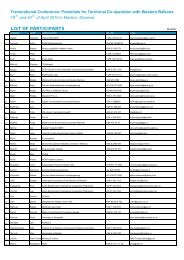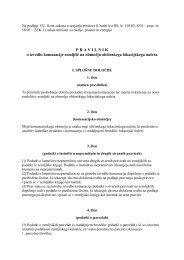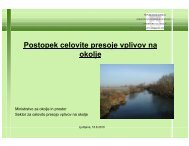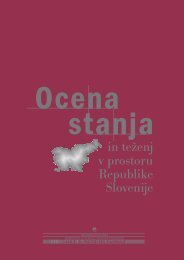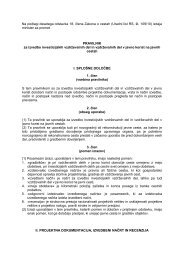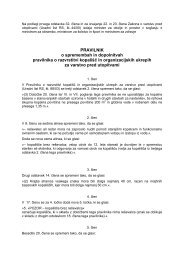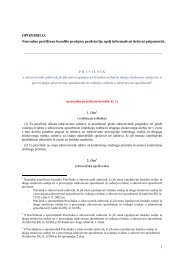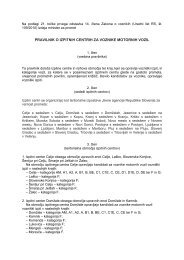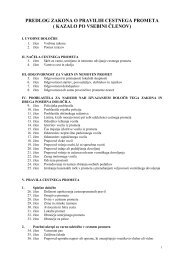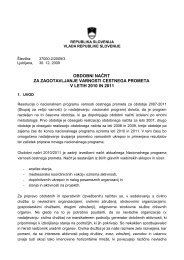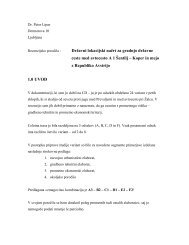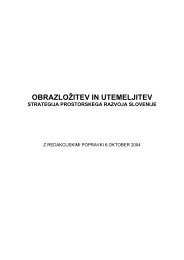evropska konvencija o krajini - Ministrstvo za infrastrukturo in prostor
evropska konvencija o krajini - Ministrstvo za infrastrukturo in prostor
evropska konvencija o krajini - Ministrstvo za infrastrukturo in prostor
You also want an ePaper? Increase the reach of your titles
YUMPU automatically turns print PDFs into web optimized ePapers that Google loves.
44Delavnica 1 / Workshop 1ter posameznikovim videnjem <strong>in</strong> vrednotenjemtega istega <strong>prostor</strong>a ali teh istih kraj<strong>in</strong>.V kraj<strong>in</strong>skem načrtovanju se vedno znovasrečujemo s potrebo po opredelitvi kraj<strong>in</strong>skeidentitete na vseh ravneh načrtovanja, odlokalne do regionalne ali celo državne. Vvsakdanjem ravnanju je ta največkrat zmotnopojmovana kot stanje, kot nespremenljiva fizičnapojavnost, medtem ko gre prav<strong>za</strong>prav <strong>za</strong> vednoznova nastajajoči odnos med neko fizičnopojavnostjo kraj<strong>in</strong>e <strong>in</strong> pogledom nanjo. Kraj<strong>in</strong>enastajajo z v<strong>za</strong>jemnim delovanjem med<strong>prostor</strong>om ter posamezniki <strong>in</strong> družbo, ki ga ssvojim delovanjem sprem<strong>in</strong>jajo. Prostor resdalahko opišemo s fizičnimi prv<strong>in</strong>ami, ki gasestavljajo, vendar v tem primeru razberemosamo kraj<strong>in</strong>sko podobo v trenutnem časovnempreseku, ne da bi razumeli, v kakšen kontekstuse pojavlja v družbeni predstavi.Zato se pojavlja vprašanje, kaj sploh je kraj<strong>in</strong>skaidentiteta. To vprašanje je aktualno na regionalni<strong>in</strong>, kot bomo videli, kljub težnji po odmiranjunacionalne države, tudi na nacionalni ravni. Tovprašanje bo najbrž znotraj Evropske skupnostivedno bolj <strong>za</strong>nimivo, saj se prvič posamezni deliEU ponovno sprašujejo o svoji identiteti <strong>in</strong>drugič, vzporedno nastaja tudi nova <strong>evropska</strong><strong>prostor</strong>ska identiteta. Lahko soobstajajo?Če predpostavimo, da gre ob izmerljivem <strong>in</strong>stvarnem, čemur bi lahko rekli identiteta kraj<strong>in</strong>e,pri iskanju kraj<strong>in</strong>ske identitete bolj <strong>za</strong> odnos dokraj<strong>in</strong>e, <strong>za</strong> identifikacijo s kraj<strong>in</strong>o, je njihovsoobstoj možen. Kot posamezniki <strong>in</strong> družba selahko identificiramo z več stvarmi, v tem primeruz več ravnmi kraj<strong>in</strong>e hkrati. Pri nacionalniidentifikaciji gre seveda <strong>za</strong> to, da se jenavezovala na tiste kraj<strong>in</strong>e, v katere je bilspontano (ali namenoma) <strong>in</strong>vestiran smisel, sajse prav <strong>za</strong>radi pripisovanja pomenov identitetane navezuje na <strong>prostor</strong> sam po sebi, temveč na<strong>in</strong>gs. The frame is shaped by culture, conventionand cognition 3 . Therefore it is important to presumethat differences can be found betweenphysical descriptions of landscapes (such as typologicalclassification for example) and <strong>in</strong>dividualor social perception and evaluation ofthese very same landscapes.In landscape plann<strong>in</strong>g we constantly encounterthe problem of how to def<strong>in</strong>e the identity of thelandscape. This happens on all levels of plann<strong>in</strong>g,from local to regional, even on the statelevel. What immediately comes to light <strong>in</strong> thiscontext is the problem of the erroneous perceptionof spatial identity as unchangeable; it isdealt with as a physical phenomenon, while <strong>in</strong>reality it <strong>in</strong>volves ever new relationships s<strong>in</strong>celandscape are created through the reciprocal<strong>in</strong>teraction between the spatial reality and theperception of this spatial reality.They are created by the <strong>in</strong>teraction between thespace and <strong>in</strong>dividuals and society who changethe space and <strong>in</strong>scribe their history on it throughtheir actions. A certa<strong>in</strong> space can be describedaccord<strong>in</strong>g to the physical components of whichit is composed, but <strong>in</strong> this case we grasp only itsimage <strong>in</strong> a particular moment <strong>in</strong> time, withoutany understand<strong>in</strong>g of values that are expressedthrough the social identification with that space.What landscape identity is <strong>in</strong> general and howit comes <strong>in</strong>to be<strong>in</strong>g? This is a current question onregional and, despite the wither<strong>in</strong>g away of theconcept of the national state, on national level aswell. This is why we can assume that this questionmight as well be quite <strong>in</strong>terest<strong>in</strong>g with<strong>in</strong> theEuropean Union, firstly, because <strong>in</strong>dividual partsof the European Union start re-engag<strong>in</strong>g <strong>in</strong> thequest for their regional (or national) identitywith<strong>in</strong> this new political context and, secondly,a new, European spatial identity gets formedalong the way. Can they coexist?1. a, b, cV Sloveniji prevladuje podoba idiličnega podeželja, polnega naravnih lepot, obdanih z vencem gora. Največkrat se s to podobo tudi predstavljamonavzven; je podoba, ki jo pr<strong>in</strong>ašamo na svetovni trg.In Slovenia the conception prevails of an idyllic countryside full of natural beauties and surrounded by a wreath of mounta<strong>in</strong>s. In most cases we alsopresent ourselves abroad with such a picture; it is a picture we br<strong>in</strong>g to the world market.



